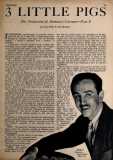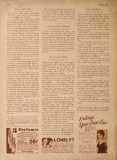

IN CONTINUING our discussion of animated cartoons, under the title of "3 Little Pigs" (because that picture brought the animated comic game into the limelight recently), I secured a statement from a producer of comedies.
"3 Little Pigs" took four months to make; it didn’t take M-G-M that long to make "Dinner at Eight" and "Fugitive Lovers" combined. But neither of these were comedies.
"Animated cartoons have changed the entire psychology of ‘human’ comedies," Al Christie, who has been producing comedies for over two decades and has to his credit some of the biggest comedy successes ever produced, notable among which is "Charley’s Aunt," told me.
"The mechanical tricks which, for many years, had been an integral part of motion picture comedies, have been almost completely taken over by the cartoons, and since it is true that the cartoon animals have a quality of appeal that no human can compete with, the only logical thing was to withdraw in their favor.
"Gag comedies are, therefore, now quite obsolete, and in their wake comes the ‘personality’ comedy, stronger now than ever. I wouldn’t attempt, in the new order of things, to make a comedy without a strong comedy personality. Because I share this opinion with the executives of the company with which I am affiliated. Educational Pictures embarked on a talent hunt which has resulted in the most impressive line-up of top-notch names ever corralled by a short subjects company.
"Stoopnagle and Budd, Ernest Truex, Bob Hope, Moran and Mack, Andy Clyde, Lillian Roth, Eddie Craven, Charles Judels, Tom Patricola, are among the personalities Educational has signed for its current program of two-reel comedies. Showing the extent to which we attach importance to the presence of names in our comedies. Educational has moved half of its current production activities to the East to insure availability of first rank talent. With the Broadway stage and the radio keeping a number of the topnotchers in New York, we did the equivalent of bringing the ‘mountain to Mohammed.’ The success of these comedies creates an appetite for the cartoon comedy as well, and vice versa."
In answer to many inquiries regarding the actual process used in producing Technicolor in connection with the Silly Symphonies, the following outline is presented as a brief non - technical exposition of the principal facts involved.
FIRST: The watercolor drawings are prepared with the figures drawn for animation painted on celluloid sheets which are super-imposed on a tinted background of heavy drawing paper.
SECOND: A special camera is used where – by each color value represented in the drawing is accurately photographed on the negative. An expert color cameraman and assistant supervise the chromatic work.
THIRD: This negative is developed by Technicolor from which they make the positive prints. On examination of the film, the print itself shows in miniature, the exact colors of the original. One of the great obstacles to perfection of colored motion pictures has been color fringing, (that lack of distinct outline in which adjacent shades merge with each other). This has been overcome by the high precision of the photograph and each process step thereafter. Complete utilization of color values has greatly enhanced the accuracy and charm of the picture, giving it brilliance and definition.
The Silly Symphonies achieve their smoothness in action because of the vast number of drawings used, which frequently approximate the exact number of frames on the film. There is great public demand for color motion pictures and with the present perfection of the process, undoubtedly this field is just beginning to show its extensive possibilities.
The new Disney cartoon concerning the adventures of the Three Little Pigs is rapidly nearing completion as this issue hits the newsstands. The title, "Little Red Riding Hood" was selected because it gives the big bad wolf an opportunity to get back into the picture. It is the sensible pig, who builds his house of stone, who rescues Red Riding Hood from the big bad wolf.
It took four months of actual work, after the story was approved, to make "Three Little Pigs." Every Silly Symphony consists of about 12,000 separate frames, or original drawings. Many of the frames must be duplicated and worked into other frames. It would take one man two years to draw a Mickey Mouse Silly Symphony by himself.
It is, therefore, the co-operation, or what Disney calls his happy family, that makes these animated cartoons a success. He doesn't approve of his staff screen credit, because it might cause jealousy among the members. He was a trifle frightened by the publicity given to Frank Churchill, the staff member who wrote the music for the three pigs.
Churrhill, by the way, wrote the opening musical phrase, "Who's afraid of the big bad wolf," in three minutes. Wich of the staff members suggested the blue coloring when the wolf blew and blew is not known, and they're not telling over at the studio. But the idea was a "swell" one.
"Three Little Pigs" was directed by Bert Gillett. Each of these animated cartoons has a director. The director must know how to draw, and he must be a hit of an actor. He directs drawn pictures, and must dramatize the roles the way he wants the figures portrayed artistically.
[…]